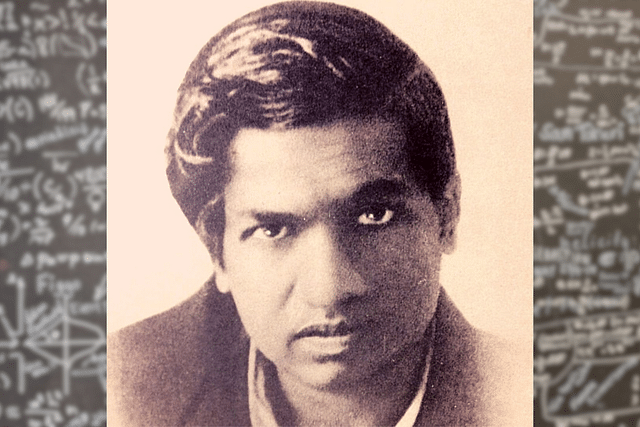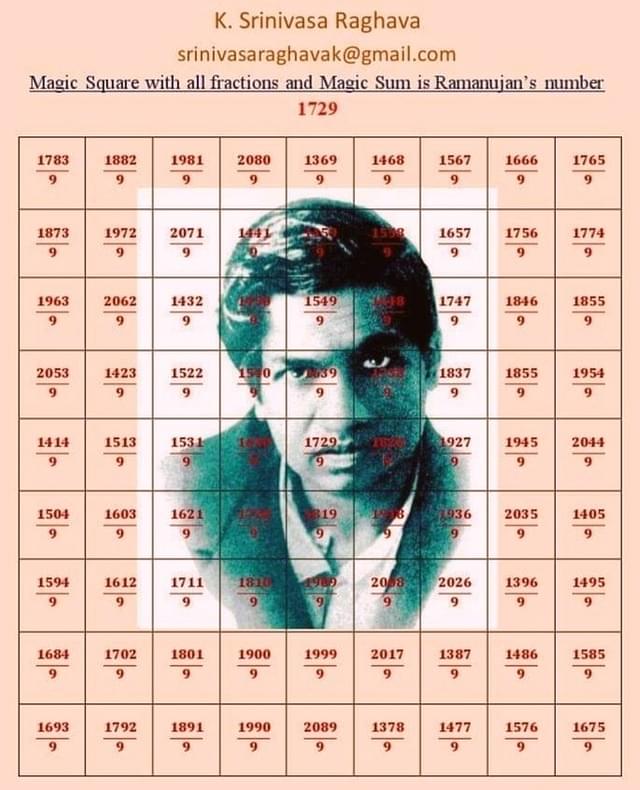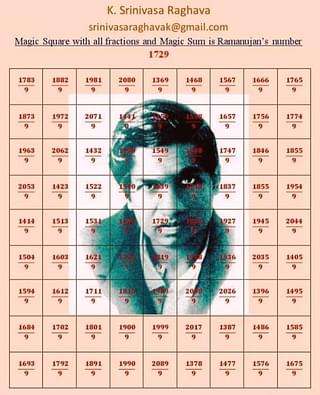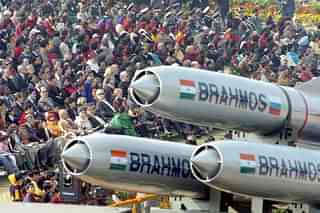Science
One Who Integrated Intuition And Innovation — The Great Ramanujan's Legacy In The Age Of AI
Srinivasa Raghava K
Dec 22, 2023, 12:34 PM | Updated 12:41 PM IST
Save & read from anywhere!
Bookmark stories for easy access on any device or the Swarajya app.

Srinivasa Ramanujan, an eminent mathematician, emerged from modest origins to attain a revered status in the field of mathematics during the twentieth century.
He was born in 1887 in Erode, India, and is renowned for his exceptional commitment, innate aptitude, and profound passion for mathematics.
Despite his limited formal education and financial challenges, Ramanujan's remarkable aptitude for mathematics was clear, setting him apart in his area.
He developed thousands of results independently, many of which were later proven to be novel and profoundly significant.
Ramanujan's mathematics was not just a collection of theorems and formulas; it was an art form, brimming with creativity and intuition.
He worked extensively in fields such as infinite series, number theory, continued fractions, q-series, and modular functions.
One of his most famous contributions is the infinite series for π (pi), which not only displayed his mathematical ingenuity but also revolutionised the way calculations for π were done, contributing significantly to the field.
His notebooks, filled with theorems, conjectures, and equations, were decades ahead of their time. For instance, his work on mock theta functions, initially a mystery to contemporary mathematicians, found applications in areas as diverse as number theory, representation theory, and even quantum mechanics.
The comparison of Ramanujan’s intuitive and self-taught approach to mathematics with the structured and data-driven processes of modern artificial intelligence (AI) offers a fascinating study of contrasts.
While AI, with its vast computational capabilities and algorithmic precision, represents a pinnacle of technological progress, Ramanujan’s story is a testament to the untapped potential of the human mind and its ability to transcend the limitations of its environment through sheer intellect and passion.
This article examines the similarities and differences between the cognitive processes of AI, a creature of structured logic and enormous data processing capability, and Ramanujan, someone whose life was a combination of struggle and brilliance.
We take a closer look at how each has made a distinct contribution to the fields of mathematics and technology, influencing our understanding in ways that were previously unthinkable.
Intuitive Insight Vs Data-Driven Logic
The comparison between Ramanujan's intuitive mathematical insights and AI's data-driven logic illustrates two distinct approaches to mathematics.
Ramanujan, largely self-taught, relied on intuition and creativity, making significant contributions to number theory and infinite series for π (pi) through intuitive leaps rather than systematic analysis.
In contrast, AI employs data-driven logic and algorithms, excelling in pattern recognition and problem-solving within large datasets, such as optimising logistical routes.
The interplay of Ramanujan's intuition and AI's computation highlights the potential for combining these methods for groundbreaking discoveries.
While Ramanujan's approach was characterised by personal insight and serendipity, AI's strength lies in processing data and executing algorithms efficiently.
Together, they represent a fascinating dialogue between human creativity and technological progress, each contributing uniquely to the advancement of mathematics and technology.
Self-Taught Learning Vs Structured AI Algorithms
The difference between Ramanujan's intuitive, self-learn approach to mathematics and the structured, data-centric learning of AI highlights two different ways of acquiring knowledge.
Ramanujan, starting with only basic textbooks, explored deeper into mathematics, driven by his natural curiosity and talent. He made groundbreaking discoveries, such as the Rogers-Ramanujan identities, without formal guidance.
In contrast, AI relies on structured algorithms and data, learning from patterns in large datasets to create predictive models and optimise solutions, yet lacking Ramanujan’s ability for intuitive leaps.
This juxtaposition highlights the unique strengths and limitations of human and machine intelligence. Ramanujan’s exploratory approach shows the power of human curiosity and innovation, while AI excels in processing data and algorithmic precision.
The potential synergy between the two, like using AI to explore Ramanujan’s unproven conjectures, illustrates how they can complement each other in advancing knowledge and technology.
Originality And Creativity: The Human Advantage
The contrast between Ramanujan's creative, original approach to mathematics and the capabilities of AI highlights the divide between human and machine intelligence.
Ramanujan's work, such as his innovative series for π and the partition function of integers, demonstrated a level of originality and creative problem-solving beyond the current scope of AI.
AI excels in pattern recognition and data optimisation but lacks the human capacity for true innovation and the creation of novel concepts.
While AI operates within its programmed parameters and can't emulate human creativity, Ramanujan's legacy inspires the development of new AI algorithms. His mathematical innovations encourage AI applications in unexplored areas and complex problem-solving.
Ultimately, Ramanujan's work underscores the unique human ability for creative thought, highlighting the complementary roles of human ingenuity and AI in advancing various fields.


Ethical And Philosophical Aspects: Beyond Computation
Exploring the differences between Ramanujan's mathematical approach and AI reveals a clear division between human and machine intelligence, especially in ethical and philosophical areas.
Ramanujan's work was deeply personal and philosophical, often linked to spiritual inspiration and seeing mathematics as an art. In stark differentiation, AI, while technically advanced, lacks the capacity for ethical understanding and philosophical reflection, highlighting a distinct nature of intelligence.
AI operates on algorithms and data without the ability to make ethical judgements or engage with philosophical concepts, a limitation evident in areas requiring moral and ethical decision-making, such as healthcare or judicial sentencing.
In contrast, Ramanujan's mathematical journey demonstrates the profound capacity of human intelligence to intertwine computation with ethical and philosophical understanding, underscoring the unique value of human insight in areas beyond the scope of AI.
Ramanujan's Legacy In Modern Technology
Ramanujan's legacy significantly impacts modern technology and the scientific community, transcending traditional mathematics. His intuitive methods and groundbreaking work have practical applications in fields like computer science, cryptography, physics, and engineering.
In computer science, Ramanujan's partition theory advances algorithm development, crucial in optimising computing processes. His number theory contributions are vital in cryptography, underpinning modern digital security.
In physics, his work on infinite series and continued fractions aids in quantum theory, enhancing understanding of quantum systems. Additionally, his mathematics improves signal processing in engineering, optimising algorithms for digital signal management.
Ramanujan's approach influences theoretical computer science, particularly in complexity theory and innovative algorithm design. His unresolved problems and interdisciplinary perspective continue to inspire scientific research, pushing the boundaries of knowledge and fostering an integrative approach to science and technology.
Furthermore, Ramanujan's story enriches mathematical education and permeates popular culture, highlighting the role of natural talent and creativity in mathematical discovery. His enduring influence underscores the timeless nature of his contributions and their ongoing impact on technology and human understanding.
Bridging Genius And Algorithms: The Ramanujan Machine
The Ramanujan Machine, developed by the Technion - Israel Institute of Technology, represents a fusion of Ramanujan's intuitive mathematical approach and AI's computational efficiency.
Designed to replicate Ramanujan's formula-discovery methods, it exemplifies the synergy between human-inspired creativity and algorithmic power, reflecting the themes of human ingenuity and AI in advancing mathematical knowledge.
Ramanujan represents the apex of human creativity and success, a monument to the human mind's unique possibilities. His legacy reminds us that, while AI might perform amazing computational feats, it will never approach the intuitive heights of a mind like Ramanujan's.
Looking ahead, we want to see the development of minds like Ramanujan's, pushing the bounds of mathematical discovery and human potential even further.
Save & read from anywhere!
Bookmark stories for easy access on any device or the Swarajya app.
Srinivasa Raghava K is a mathematics researcher and Vedic maths instructor deeply inspired by Srinivasa Ramanujan's work, especially the Theory of Numbers and Cryptography. Recognised with prestigious awards like the A P J Abdul Kalam Innovative Research Award, Math Genius Title, and Prathibha Shiromani Award, he has shared his insights at over 135 international and national conferences.
Support Swarajya's 50 Ground Reports Project & Sponsor A Story
Every general election Swarajya does a 50 ground reports project.
Aimed only at serious readers and those who appreciate the nuances of political undercurrents, the project provides a sense of India's electoral landscape. As you know, these reports are produced after considerable investment of travel, time and effort on the ground.
This time too we've kicked off the project in style and have covered over 30 constituencies already. If you're someone who appreciates such work and have enjoyed our coverage please consider sponsoring a ground report for just Rs 2999 to Rs 19,999 - it goes a long way in helping us produce more quality reportage.
You can also back this project by becoming a subscriber for as little as Rs 999 - so do click on this links and choose a plan that suits you and back us.
Click below to contribute.





